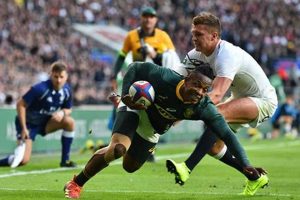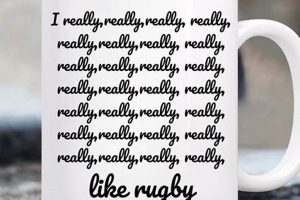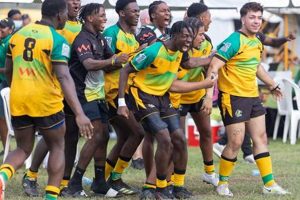Rugby union second rows are specialized forwards who play a crucial role in the game. They are typically the tallest and heaviest players on the field, and their primary responsibilities involve securing the ball in the line-out and disrupting the opposition’s set-pieces.
Editor’s Notes:Rugby union second rows are essential for any team looking to succeed. They provide a physical presence in the forwards and are often responsible for winning crucial turnovers.
We’ve analyzed the different aspects of rugby union second rows and put together this guide to help you understand their roles and responsibilities. Whether you’re a player, coach, or fan, this guide will provide you with all the information you need to know about rugby union second rows.
Key Differences Between Second Rows and Other Positions
| Second Rows | Other Positions | |
|---|---|---|
| Primary Responsibility | Securing the ball in the line-out and disrupting the opposition’s set-pieces | Varies depending on position |
| Physical Attributes | Typically the tallest and heaviest players on the field | Varies depending on position |
| Skills | Jumping, catching, tackling, and rucking | Varies depending on position |
The Role of Second Rows in Rugby Union
Second rows play a vital role in rugby union. They are responsible for:
- Securing the ball in the line-out
- Disrupting the opposition’s set-pieces
- Tackling and rucking
- Carrying the ball
- Supporting the backs
Second rows are often the unsung heroes of rugby union. They do not score as many tries as the backs, but they are essential for any team looking to succeed.
Conclusion
Rugby union second rows are an essential part of the game. They are physical, skilled, and determined players who play a vital role in their team’s success.
1. Line-out
The line-out is a crucial part of rugby union, and second rows play a vital role in this aspect of the game. They are responsible for securing the ball in the line-out, which gives their team possession and allows them to launch an attack. To be successful in the line-out, second rows must be tall, athletic, and have excellent jumping and catching skills.
There are two main types of line-outs: attacking line-outs and defensive line-outs. In an attacking line-out, the team with possession of the ball will try to win the ball and then launch an attack. In a defensive line-out, the team without possession of the ball will try to disrupt the opposition’s line-out and prevent them from winning the ball.
Second rows are essential for both attacking and defensive line-outs. In an attacking line-out, they will try to jump high and catch the ball above the opposition. Once they have the ball, they will then try to drive forward and create a platform for their team to attack. In a defensive line-out, second rows will try to disrupt the opposition’s line-out by jumping up and contesting the ball. They will also try to put pressure on the opposition’s jumpers and make it difficult for them to catch the ball.
The line-out is a complex and challenging part of rugby union, but second rows play a vital role in this aspect of the game. They are responsible for securing the ball and giving their team possession, and they can also be a major factor in disrupting the opposition’s line-out.
Key Insights:
- Second rows are responsible for securing the ball in the line-out, which gives their team possession and allows them to launch an attack.
- To be successful in the line-out, second rows must be tall, athletic, and have excellent jumping and catching skills.
- Second rows play a vital role in both attacking and defensive line-outs.
Practical Applications:
- Coaches can help their second rows improve their line-out skills by practicing different line-out drills.
- Players can improve their line-out skills by working on their jumping and catching skills.
- Teams can use their second rows to gain an advantage in the line-out by using different strategies, such as jumping high and contesting the ball, or putting pressure on the opposition’s jumpers.
2. Set-pieces
Set-pieces are an important part of rugby union, and second rows play a vital role in disrupting the opposition’s set-pieces. Set-pieces occur when the game is stopped and the ball is re-started with a set play, such as a line-out or a scrum. Second rows can disrupt the opposition’s set-pieces by charging down the line-out or scrum, or by putting pressure on the opposition’s players.
Disrupting the opposition’s set-pieces can give a team a significant advantage. For example, if a team can disrupt the opposition’s line-out, they can prevent them from winning the ball and launching an attack. Similarly, if a team can disrupt the opposition’s scrum, they can prevent them from generating momentum and driving forward.
Second rows who are good at disrupting the opposition’s set-pieces are highly valued by their teams. They can be a major factor in winning or losing a game.
Key Insights:
- Second rows play a vital role in disrupting the opposition’s set-pieces.
- Disrupting the opposition’s set-pieces can give a team a significant advantage.
- Second rows who are good at disrupting the opposition’s set-pieces are highly valued by their teams.
Practical Applications:
- Coaches can help their second rows improve their ability to disrupt the opposition’s set-pieces by practicing different drills.
- Players can improve their ability to disrupt the opposition’s set-pieces by working on their tackling and rucking skills.
- Teams can use their second rows to gain an advantage in set-pieces by using different strategies, such as charging down the line-out or scrum, or by putting pressure on the opposition’s players.
3. Tackling
Tackling is an essential part of rugby union, and second rows are some of the best tacklers in the game. They are responsible for bringing down the opposition’s ball carriers and preventing them from making gains. Second rows use a variety of tackling techniques, including the front-on tackle, the side tackle, and the wrap tackle. They must be strong, powerful, and have good timing in order to be effective tacklers.
Second rows play a vital role in their team’s defense. They a
re often the first line of defense against the opposition’s attack, and they can make a significant impact on the outcome of a game. Good tacklers can prevent the opposition from scoring tries and can also force them to make mistakes.
Key Insights:
- Second rows are some of the best tacklers in the game.
- They are responsible for bringing down the opposition’s ball carriers.
- Second rows play a vital role in their team’s defense.
Practical Applications:
- Coaches can help their second rows improve their tackling skills by practicing different tackling drills.
- Players can improve their tackling skills by working on their strength, power, and timing.
- Teams can use their second rows to gain an advantage in defense by using different tackling strategies, such as using a variety of tackling techniques and working together to support each other.
4. Rucking
Rucking is an essential part of rugby union, and second rows play a vital role in this aspect of the game. Rucking occurs when the ball is on the ground and players from both teams bind together and try to drive each other backwards. Second rows are typically involved in rucks because they are strong and powerful, and they can use their size and strength to drive the opposition backwards and win possession of the ball.
Rucking is a physically demanding and challenging part of rugby union, but it is also an important one. Teams that are good at rucking can gain a significant advantage over their opponents. Second rows who are good at rucking can help their team win possession of the ball, and they can also slow down the opposition’s attack and prevent them from scoring tries.
Key Insights:
- Rucking is an essential part of rugby union, and second rows play a vital role in this aspect of the game.
- Second rows are typically involved in rucks because they are strong and powerful, and they can use their size and strength to drive the opposition backwards and win possession of the ball.
- Teams that are good at rucking can gain a significant advantage over their opponents.
Practical Applications:
- Coaches can help their second rows improve their rucking skills by practicing different rucking drills.
- Players can improve their rucking skills by working on their strength, power, and teamwork.
- Teams can use their second rows to gain an advantage in rucking by using different rucking strategies, such as using a variety of rucking techniques and working together to support each other.
5. Carrying
Carrying the ball is an important part of rugby union, and second rows often play a key role in this aspect of the game. Second rows are typically strong and powerful, and they can use their size and strength to break through the opposition’s defense and gain yards for their team. Second rows may also be called upon to carry the ball in close to the opposition’s try line, in order to score a try.
There are a number of different ways that second rows can carry the ball. They can run straight at the opposition’s defense, or they can use their strength to fend off tacklers and break through the line. Second rows can also use their footwork to step around defenders and gain yards.
The ability to carry the ball effectively is an important skill for second rows. Second rows who are good at carrying the ball can help their team gain territory and score tries.
Key Insights:
- Carrying the ball is an important part of rugby union, and second rows often play a key role in this aspect of the game.
- Second rows are typically strong and powerful, and they can use their size and strength to break through the opposition’s defense and gain yards for their team.
- The ability to carry the ball effectively is an important skill for second rows.
Practical Applications:
- Coaches can help their second rows improve their carrying skills by practicing different carrying drills.
- Players can improve their carrying skills by working on their strength, power, and footwork.
- Teams can use their second rows to gain an advantage in carrying by using different carrying strategies, such as using a variety of carrying techniques and working together to support each other.
6. Supporting
In rugby union, second rows play a vital role in supporting the backs. This involves running into space and providing options for the ball carrier. Second rows do this by creating space for the ball carrier to run into, and by providing a target for the ball carrier to pass to. This allows the backs to attack the opposition’s defense and score tries.
There are a number of different ways that second rows can support the backs. One way is to run into space and create a hole for the ball carrier to run through. This can be done by running straight at the opposition’s defense, or by running around the side of the ruck. Another way that second rows can support the backs is to provide a target for the ball carrier to pass to. This can be done by standing in space and waiting for the ball carrier to pass to them, or by running into space and creating a mismatch for the opposition’s defense.
The ability to support the backs is an important skill for second rows. Second rows who are good at supporting the backs can help their team to create scoring opportunities and win games.
Key Insights:
- Second rows play a vital role in supporting the backs.
- Second rows can support the backs by creating space for the ball carrier to run into, and by providing a target for the ball carrier to pass to.
- The ability to support the backs is an important skill for second rows.
Practical Applications:
- Coaches can help their second rows to improve their supporting skills by practicing different supporting drills.
- Players can improve their supporting skills by working on their running and passing skills.
- Teams can use their second rows to gain an advantage in attack by using different supporting strategies, such as using a variety of supporting techniques and working together to create space for the ball carrier.
7. Physicality
Physicality is a key aspect of rugby union second rows. Second rows are typically the tallest and heaviest players on the field, and they must be strong and athletic to be effective. This physicality allows second rows to perform their roles in the game, such as securing the ball in the line-out, disrupting the opposition’s set-pieces, and tackling and rucking.
One of the most important aspects of a second row’s physicality is their strength. Second rows need to be strong in order to lift their opponents in the line-out, to drive them backwards in the scrum, and to tackle them effectively. Second rows also need to be athletic in order to be able to jump high in the line-out, to run fast and tackle effectively, and to change di
rection quickly.
There are a number of benefits to having a strong and athletic second row. For example, a strong second row can help their team to win the ball in the line-out, which can give their team possession and allow them to launch an attack. A strong second row can also help their team to disrupt the opposition’s set-pieces, which can prevent the opposition from scoring points. A strong and athletic second row can also help their team to tackle effectively and to ruck effectively, which can help their team to gain territory and to win the game.
There are a number of challenges that second rows face due to their physicality. For example, second rows are often targeted by the opposition, as they are seen as a weak link in the defense. Second rows also need to be able to handle the physical demands of the game, which can be very demanding. However, the benefits of having a strong and athletic second row outweigh the challenges.
Here are some specific examples of how the physicality of second rows can impact the game of rugby union:
- In the line-out, a strong second row can help their team to win the ball by lifting their opponents and driving them backwards. This can give their team possession of the ball and allow them to launch an attack.
- In the scrum, a strong second row can help their team to disrupt the opposition’s set-piece by driving them backwards. This can prevent the opposition from scoring points and can give their team possession of the ball.
- In the tackle, a strong second row can help their team to stop the opposition’s attack. Second rows can tackle effectively by wrapping their arms around the opposition player and driving them to the ground.
- In the ruck, a strong second row can help their team to win possession of the ball. Second rows can ruck effectively by binding onto the opposition players and driving them backwards.
Overall, the physicality of second rows is a key aspect of rugby union. Second rows use their strength and athleticism to perform their roles in the game, and they can have a major impact on the outcome of a match.
8. Leadership
Leadership is an essential quality for any rugby union second row. Second rows are often leaders on their teams, and they are responsible for motivating their teammates and setting an example. This is because second rows are typically experienced players who have a good understanding of the game. They are also physically strong and athletic, which makes them respected by their teammates.
There are a number of reasons why leadership is important for second rows. First, second rows are often the focal point of the team’s defense. They are responsible for securing the ball in the line-out and disrupting the opposition’s set-pieces. This means that they need to be able to communicate effectively with their teammates and organize the defense. Second, second rows are often called upon to carry the ball in close to the opposition’s try line. This means that they need to be able to make good decisions under pressure and lead their team to victory.
There are a number of examples of great leaders who have played the position of second row in rugby union. One example is Martin Johnson, who captained England to victory in the 2003 Rugby World Cup. Johnson was a world-class second row who was known for his leadership skills. He was a tough and physical player, but he also had a good understanding of the game and was able to motivate his teammates.
Another example of a great leader who played the position of second row is John Eales, who captained Australia to victory in the 1999 Rugby World Cup. Eales was a world-class second row who was known for his leadership skills. He was a courageous and determined player, and he was always able to get the best out of his teammates.
Leadership is an essential quality for any rugby union second row. Second rows who are good leaders can help their team to succeed on and off the field.
Key Insights:
- Leadership is an essential quality for any rugby union second row.
- Second rows are often leaders on their teams, and they are responsible for motivating their teammates and setting an example.
- There are a number of examples of great leaders who have played the position of second row in rugby union.
Practical Applications:
- Coaches can help their second rows to develop their leadership skills by giving them opportunities to lead the team.
- Players can develop their leadership skills by taking on leadership roles in their club or school team.
- Teams can benefit from having a strong leader in the second row, as this can help the team to perform better on and off the field.
FAQs about Rugby Union Second Rows
Rugby union second rows are specialized forwards who play a crucial role in the game. They are typically the tallest and heaviest players on the field, and their primary responsibilities involve securing the ball in the line-out and disrupting the opposition’s set-pieces.
Question 1: What is the role of a second row in rugby union?
Answer: Second rows are responsible for securing the ball in the line-out and disrupting the opposition’s set-pieces. They must be strong, athletic, and have good jumping and catching skills.
Question 2: What are the key differences between second rows and other positions?
Answer: Second rows are typically taller, heavier, and stronger than other positions. They also have specialized skills in jumping, catching, and tackling.
Question 3: What are the physical demands of playing second row?
Answer: Second rows must be strong, athletic, and have good endurance. They must be able to jump high, tackle effectively, and ruck effectively.
Question 4: What are the leadership qualities of a second row?
Answer: Second rows are often leaders on their teams. They are responsible for motivating their teammates and setting an example. They must be able to communicate effectively and make good decisions under pressure.
Question 5: What are some of the challenges that second rows face?
Answer: Second rows are often targeted by the opposition, as they are seen as a weak link in the defense. They also need to be able to handle the physical demands of the game. However, the benefits of having a strong and athletic second row outweigh the challenges.
Question 6: What are some tips for aspiring second rows?
Answer: Aspiring second rows should focus on developing their strength, athleticism, and jumping skills. They should also work on their leadership skills and learn to communicate effectively with their teammates.
Overall, rugby union second rows are essential players who play a vital role in the game. They are strong, athletic, and skilled players who are responsible for securing the ball in the line-out and disrupting the opposition’s set-pieces.
To learn more about rugby union second rows, please visit the following resources:
- World Rugby Laws of the Game
- England Rugby Union Positions Guide
- Irish Rugby Union Positions Guide
Tips for Rugby Union Second Rows
Rugby union second rows are specialized forwards who play a crucial role in the game. They are typically the tallest and heaviest players on the field, and their primary responsibilities involve securing the ball in the line-out and disrupting the opposition’s set-pieces.
Here
are some tips for aspiring second rows:
Tip 1: Develop your strength and athleticism.
Second rows need to be strong and athletic in order to perform their roles effectively. This means focusing on developing your strength, power, and endurance. You can do this by lifting weights, doing plyometric exercises, and running regularly.
Tip 2: Improve your jumping and catching skills.
Second rows need to be able to jump high and catch the ball in the line-out. You can improve your jumping skills by practicing jumping drills and doing plyometric exercises. You can improve your catching skills by practicing catching the ball with one hand and two hands.
Tip 3: Work on your tackling and rucking skills.
Second rows need to be able to tackle effectively and ruck effectively. You can improve your tackling skills by practicing tackling drills and working on your technique. You can improve your rucking skills by practicing rucking drills and working on your strength and power.
Tip 4: Develop your leadership skills.
Second rows are often leaders on their teams. You can develop your leadership skills by taking on leadership roles in your club or school team. You can also develop your leadership skills by studying leadership books and articles.
Tip 5: Study the game of rugby union.
The more you know about the game of rugby union, the better you will be able to perform your role as a second row. You can study the game by watching matches, reading books and articles, and talking to coaches and players.
Summary:
By following these tips, you can improve your skills and knowledge as a rugby union second row. Remember to focus on developing your strength, athleticism, jumping and catching skills, tackling and rucking skills, leadership skills, and knowledge of the game.
Transition:
To learn more about rugby union second rows, please visit the following resources:
- World Rugby Laws of the Game
- England Rugby Union Positions Guide
- Irish Rugby Union Positions Guide
Conclusion
Rugby union second rows are specialized forwards who play a crucial role in the game. They are typically the tallest and heaviest players on the field, and their primary responsibilities involve securing the ball in the line-out and disrupting the opposition’s set-pieces. Second rows must be strong, athletic, skilled, and determined players in order to be effective.
In this article, we have explored the different aspects of rugby union second rows, including their roles and responsibilities, their physical and mental attributes, and their importance to the team. We have also provided some tips for aspiring second rows who want to improve their skills and knowledge of the game.
Rugby union second rows are essential players who play a vital role in the success of their team. They are the unsung heroes of the game, and they deserve our respect and admiration.







